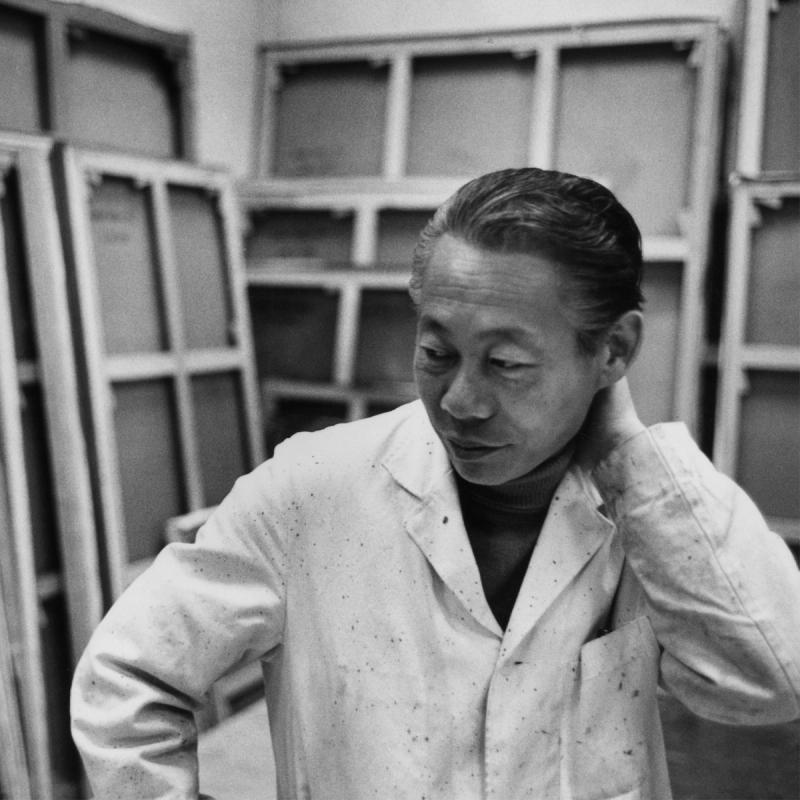Zao Wou-Ki
“Although the influence of Paris is undeniable in all my training as an artist, I also wish to say that I have gradually rediscovered China... Paradoxically, perhaps, it is to Paris I owe this return to my deepest origins.”
With his gestural, atmospheric paintings, Zao Wou-Ki (1920–2013) synthesized Eastern and Western aesthetic traditions, helping to shape lyrical abstraction in postwar Europe over six decades. Born in Peking (now Beijing) and raised in Shanghai, Zao studied and later taught at the Hangzhou School of Fine Arts. In 1948, he moved to Paris, where he began to reckon with and reconcile the long-established forms of landscape and calligraphic ink painting of his classical training and the Impressionism and Expressionism he admired in France, finding resonance in the two. Zao befriended figures such as Alberto Giacometti, Joan Miró, and Henri Michaux, and, with the artists associated with the École de Paris, worked to expand the boundaries of expressionist abstraction in painting. He worked predominantly in oils, watercolor, and ink, but also experimented with engravings and lithography. In 1949, his first solo exhibition in Paris was mounted at Galerie Creuze. He traveled to New York frequently since 1957, spending time with Barnett Newman and Franz Kline; and in 1959, his work debuted in New York with Samuel Kootz, the legendary dealer of Abstract Expressionism. The span from 1959 to 1972 has been sometimes referred to as Zao’s prolific Hurricane Period, wherein he expanded the scale of his canvases and integrated calligraphy-inspired brushwork.
Among his extensive solo exhibitions worldwide, recent retrospectives of Zao’s work include those organized by Jeu de Paume, Paris (2003); Bridgestone Museum of Art, Tokyo (2004); French National Library, Paris (2008); Asia Society, New York (2016); and Musée d’Art Moderne de la Ville de Paris (2018). His work resides in such collections as the Centre Pompidou, Paris; China Academy of Art, Hangzhou, and Suzhou Museum; Hong Kong Museum of Art and M+, Hong Kong; Artizon Museum, Tokyo; Metropolitan Museum of Art and Solomon R. Guggenheim Museum, New York; Hirshhorn Museum and Sculpture Garden, Washington, DC; and Tate, London, among many others. A member of the prestigious Académie des Beaux-Arts, Zao was honored with the Japan Art Association’s Praemium Imperiale for Painting (1994). In 2006, he was promoted to the rank of Grand Officer into the Ordre National de la Légion d’Honneur, France’s highest order of merit.
Exhibitions
Selected Artworks
- Zao Wou-Ki
- Sans titre, 2006
- India ink on paper
- 108¹⁄₁₆ × 84¹⁄₁₆ inches (274.5 × 213.5 cm)
- Zao Wou-Ki
- 21.11.03, 2003
- Oil on canvas
- 76¾ × 51³⁄₁₆ inches (195 × 130 cm)
- Zao Wou-Ki
- Triptyque 2000 - 23.12.2001, 2000
- Oil on canvas
- 86⅝ × 295¼ inches (220 × 750 cm)
- Zao Wou-Ki
- 11.11.96,
- Oil on canvas
- 78¾ × 63¾ inches (200 × 162 cm)
- Zao Wou-Ki
- 25-03-85, 1985
- Oil on canvas
- 51 × 63⁷⁄₁₆ inches (129.5 × 161.2 cm)
- Zao Wou-Ki
- 27-10-1981, 1981
- Oil on canvas
- 39⅜ × 31⅞ inches (100 × 81 cm)
- Zao Wou-Ki
- 17.02.71–12.05.76, 1971
- Oil on canvas
- 28¾ × 39⅜ inches (73 × 100 cm)
- Zao Wou-Ki
- 14.11.61, 1961
- Oil on canvas
- 51³⁄₁₆ × 63¾ inches (130 × 162 cm)
Selected Press
- Connaissance des ArtsJuly 13, 2021
- The ValueApril 1, 2021
- Hong Kong TatlerMarch 23, 2021
- Tatler Hong KongJanuary 6, 2021
- China DailyNovember 27, 2020
- OculaNovember 24, 2020
- Hong Kong TatlerNovember 23, 2020
- 99YNovember 6, 2019
- ArtsyNovember 6, 2019
- The Art NewspaperFebruary 1, 2019
- ArtsyDecember 24, 2018
- BloombergSeptember 30, 2018
- Hamptons Art HubDecember 27, 2017
- ArtnetJune 8, 2017
- Wall Street InternationalFebruary 13, 2017
- Hamptons Art HubFebruary 7, 2017
- CulturedFebruary 1, 2017
- ArtnetJanuary 10, 2017
